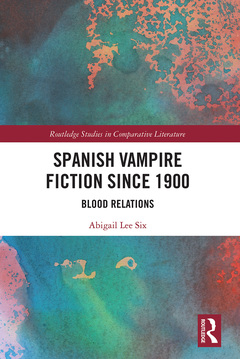Spanish Vampire Fiction since 1900 Blood Relations Routledge Studies in Comparative Literature Series
Auteur : Lee Six Abigail

Spanish Vampire Fiction since 1900: Blood Relations, as that subtitle suggests, makes the case for considering Spanish vampire fiction an index of the complex relationship between intercultural phenomena and the specifics of a time, place, and author. Supernatural beings that drink blood are found in folklore worldwide, Spain included, and writers ranging from the most canonical to the most marginal have written vampire stories, Spanish ones included too. When they do, they choose between various strategies of characterization or blend different ones together. How much will they draw on conventions of the transnational corpus? Are their vampires to be local or foreign; alluring or repulsive; pitiable or pure evil, for instance? Decisions like these determine the messages texts carry and, when made by Spanish authors, may reveal aspects of their culture with striking candidness, perhaps because the fantasy premise seems to give the false sense of security that this is harmless escapism and, since metaphorical meaning is implicit, it is open to argument and, if necessary, denial.
Part I gives a chronological text-by-text appreciation of all the texts included in this volume, many of them little known even to Hispanists and few if any to non-Spanish Gothic scholars. It also provides a plot summary and brief background on the author of each. These entries are free-standing and designed to be consulted for reference or read together to give a sense of the evolution of the paradigm since 1900. Part II considers the corpus comparatively, first with regard to its relationship to folklore and religion and then contagion and transmission.
Spanish Vampire Fiction since 1900: Blood Relations will be of interest to Anglophone Gothic scholars who want to develop their knowledge of the Spanish dimension of the mode and to Hispanists who want to look at some canonical texts and authors from a new perspective but also gain an awareness of some interesting and decidedly non-canonical material.
Acknowledgements
Introduction
Part I: Text-by-Text Analysis
1. Ramón del Valle-Inclán, "Beatriz/Satanás"
2. Emilia Pardo Bazán, "Vampiro"
3. Antonio de Hoyos y Vinent, "Una hora de amor" and "El señor Cadáver y le señorita Vampiro"
4. Carmen de Burgos, La mujer fría
5. Wenceslao Fernández Flórez, "El claro del bosque"
6. Alfonso Sastre, "Las noches del Espíritu Santo"
7. Juan G. Atienza, "Sangre fresca para el muerto"
8. Alfons Cervera, "Historia de amor"
9. Adelaida García Morales, La lógica del vampiro
10. Mercedes Abad, Sangre
11. Javier García Sánchez, Ella, Drácula: Erzsébet Báthory
12. Clara Tahoces, Gothika
13. Santiago Exímeno, "Al caer la noche"
14. David Jasso, "Víctimas inocentes"
15. Alfredo Álamo, "El hombre de la pala"
16. Elia Barceló, "La belle dame sans merci"
17. Nuria C. Botey, "Viviendo con el tío Roy"
18. Miguel Puente Molins, "Caries"
19. Juan Ignacio Carrasco, Entre nosotros
20. José de la Rosa, Vampiro
21. Marc R.Soto, "Siempre en mi recuerdo"
22. José María Tamparillas, "El sabor de la buena tierra", "Sangre de mi sangre, carne de mi carne" and "La vieja, la muy vieja Betty"
23. Lorenzo Fernández Bueno, El vampiro de Silesia
24. Carlos Molinero, Verano de miedo
25. Gema del Prado Marugán, "Comer con los ojos"
26. Edgar Sega, "Los dos mundos de Lord Barrymore"
Part II: Comparative Analysis27. Folklore and Religion
28. Contagion and Transmission
Conclusion
Bibliography
Index
Abigail Lee Six is Professor of Spanish at Royal Holloway, University of London, UK. Among the first Hispanists to argue for taking the Gothic beyond a narrow chronological definition, The Gothic Fiction of Adelaida García Morales: Haunting Words and Gothic Terrors: Incarceration, Duplication, and Bloodlust in Spanish Narrative showcase her research.
Date de parution : 06-2021
15.2x22.9 cm
Date de parution : 02-2019
15.2x22.9 cm
Thème de Spanish Vampire Fiction since 1900 :
Mots-clés :
Young Man; Las Cuencas; coagulations; UK Score; Ramón del Valle-Inclán; Por Ellas; Emilia Pardo Bazán; Demarcation Line; Vampiro; Las Brujas; Antonio de Hoyos y Vinent; Spanish Cultural Context; La Mujer Fria; Home Town; Carmen de Burgos; Limpieza De Sangre; Wenceslao Fernández Flórez; Vampire Fiction; Juan Perucho; Lord Barrymore; Las Historias Naturales; La Condesa; Alfonso Sastre; Gangster Film; Las noches de espiritu santo; Human Suffering; Juan G; Atienza; Draws Back; Alfons Cervera; De Roja; Adelaida García Morales; La Vieja; Mercedes Abad; Sangre; blood; contemporary literature; literatura espanola; vampiros espanoles; Javier García Sánchez; Dracula; Ella Dracula; José de la Rosa; Entre nosotros; Juan Ignacio Carrasco; La sangre es vida; Miguel Puente Molins; José María Tamparillas; Sangre de mi sangre; carne de mi carne; Lorenzo Fernández Bueno; La sombra de Polidori



